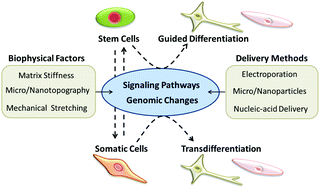A biomaterial approach to cell reprogramming and differentiation
Abstract
The cell reprogramming of somatic cells into pluripotent states and subsequent differentiation into certain phenotypes has helped progress regenerative medicine research and other medical applications. Recent research has used viral vectors to induce this reprogramming; however, limitations include low efficiency and safety concerns. In this review, we discuss how biomaterial methods offer potential avenues for either increasing viability and downstream applicability of viral methods, or providing a safer alternative. The use of non-viral delivery systems, such as electroporation, micro/nanoparticles, nucleic acids and the modulation of culture substrate topography and stiffness, has generated valuable insights regarding cell reprogramming.

- This article is part of the themed collection: Recent Review Articles


 Please wait while we load your content...
Please wait while we load your content...